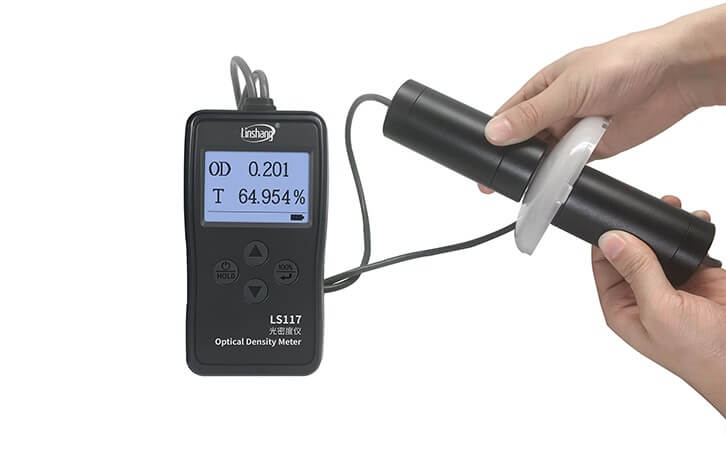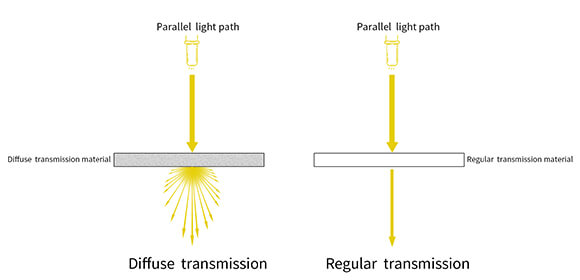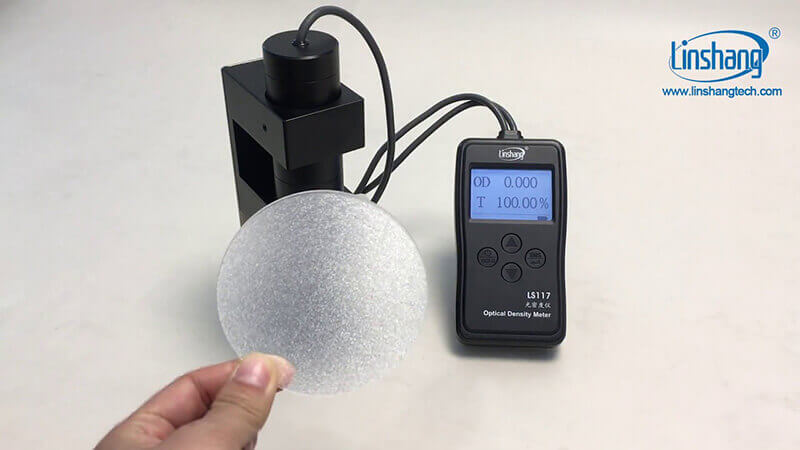Transmission densitometer & OD and light transmittance measurement
A densitometer is a device used to measure the darkness (optical density) of photographic or translucent materials or reflective surfaces. The transmission densitometer does not measure color, but density. In printing work, density is caused by the light blocking ability of pigments in the printing ink deposited on the paper during the printing process. (Quoted from wikipedia.org) Optical density and visible light transmittance can be measured by professional transmission densitometer.
I. OD and light transmittance definition and conversion

1. Definition of optical density and light transmittance
Optical density: the light passing through the tested material, the energy difference is the energy absorbed by the tested material. At a specific wavelength, the concentration of the same material to be tested has a quantitative relationship with the energy absorbed.
Transmittance: Transmittance refers to the ability of light to pass through the medium. It is the percentage of the luminous flux transmitted through the transparent or translucent body and its incident luminous flux. When the false parallel monochromatic light passes through a uniform, non-scattering medium, part of the light is absorbed, partly passes through the medium and partly is reflected by the surface of the medium. Light transmittance can indicate the efficiency of the material to transmit light. In many industries, the light transmittance and optical density of materials have a prescribed range of qualification.
2. Conversion between optical density and light transmittance
Optical density abbreviated as OD. It is defined as the logarithm of the ratio of incident light to transmitted light or the logarithm of the light transmittance reciprocal. The calculation formula is OD = log10 (incident light / transmitted light) or OD = log10 (1 / transmittance). When testing materials in general, we find that the transmittance of some materials is very low. It is difficult to compare the differences between materials using the transmittance value. If the light transmittance value is converted into the optical density value, the data will be more intuitive.
3. Dual use optical density meter measure both OD and VLT
However, some customers think that after purchasing a light transmittance meter, it is necessary to convert the measured data to obtain the desired optical density value. In fact, we only need a transmission densitometer to measure two data at the same time to solve this problem. For some X films and IR inks, the measurement of light transmittance requires a professional transmission densitometer based on the diffuse transmission principle. Why do you say this way? This is related to the surface characteristics of the tested material. The editor has deliberately organized relevant knowledge on the measurement of light transmittance and optical density of diffuse transmission materials and hopes to provide help for everyone.
II. Transmission densitometer principle
Transmission densitometer is an instrument that can measure optical density value and transmittance value at the same time. It uses the diffuse transmission principle and can replace the integrating sphere effect. This transmission densitometer is suitable for measuring translucent materials such as opalescent, frosted, etc. It can also measure high-transmittance materials, X film, aluminum coating and other materials.
The diffuse transmission principle: When light passes through a transmission material with a rough surface (such as frosted glass), the transmitted light diffuses. There is no regular transmission macroscopically, which is called diffuse transmission. If light shines on a light-transmitting material with good diffusivity (such as opalescent glass, etc.), the transmitted light will spread out in all directions and be evenly distributed in the entire hemispherical space. At this time, when the brightness is the same in all directions. This is called isotropic diffuse transmission (formerly known as uniform diffuse transmission)
When light is irradiated to translucent materials such as opalescent, frosted, etc., the light will diffuse diffusely instead of regularly transmitted on the tested material surface. This is determined by the surface characteristics of the object. If a general light transmittance meter is used to measure diffuse transmission materials, part of the light will be scattered. The instrument can’t receive all the light intensity. Therefore, for diffuse transmission materials such as opalescent, matte, film, etc., we should use the transmission densitometer using diffuse transmission principle.

III. How to measure OD and transmittance using transmission densitometer?
Let's take LS117 diffuse transmission principle transmission densitometer on the market as an example to explain how to measure the optical density value and transmittance of diffuse transmission materials.
Common diffuse transmission materials are opalescent, matte, film, lens ink, etc. If you need to test the optical density value and light transmittance of diffuse transmission materials, you can refer to the following steps (when measuring highly transparent materials and glass, you need to add black flannel):
Long press the power button to enter the setting mode in the off state.
Use the up and down buttons to select whether to shut down automatically. And press the confirm button to confirm the setting.
Choose fast or slow measurement mode, if the OD value is less than 5, it is recommended to choose fast measurement mode.
After setting, the transmission densitometer will perform self-calibration.
After self-calibration, the screen shows that the OD value is 0 and the light transmittance is 100%.
During the test, the material to be tested is placed between the two sleeves. And the optical density value and light transmittance will be automatically displayed on the screen.
IV. High-precision transmission densitometer
± 0.02 (0 --- 2.00 OD)
± 2% (2.00 --- 6.00 OD)
Visible light transmittance measurement accuracy
± 1% (0% --- 50%)
± 2% (50% --- 100%)
Special transmission densitometer must be used for optical density measurement. Since some customers do not understand the professional diffuse transmission principles, they choose ordinary light transmittance instruments on the market when measuring diffuse transmission materials, which results in inaccurate measurement data and affects the production of products. If you need to measure diffuse transmission materials, such as aluminum film, film, X-ray film, lens ink, opalescent translucent, matte materials, etc. Welcome to consult!
- LS117 Optical Densitometer Measure Welding Mask Glass
- Companre LS117 Optical Density Meter With Others
- LS117 Densitometer Measure Application
- Difference of LS117 Densitometer and X-Rite 341 Densitometer
- LS117 Transmission Densitometer-Related Knowledge
- The details of LS152 glass light transmittance on-line monitoring device

